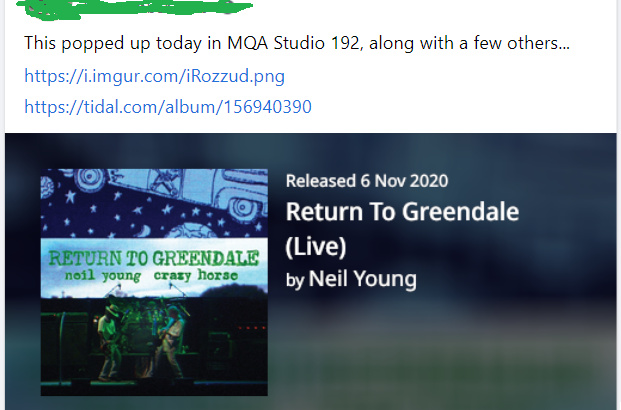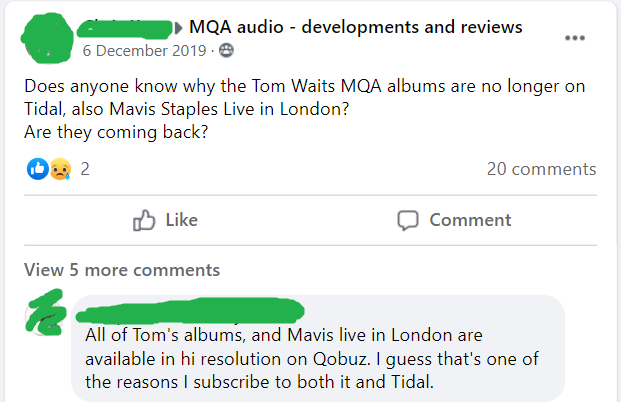I’d not be quite as strident. While upsampling information is derived, so not really new, it might sonically aid downstream DACs that aren’t perfect, i.e. all of them.
How can it help anything if there is no additional sonic information being provided?
They provide, hopefully accurate hints, as to what the result of calculating the inter-sample space mid-point should be. (Nearly?) all DACs oversample but if your added at source algorithm’s genuinely better it might help. It’ll help processing times also.
Regions B and C are reserved for the Emperor MQA’s new clothes?
Unfortunately nothing in region C is restored from the original data just upsampled
I did not understand a single word of what you said above, so I cannot even begin to check if it makes sense - is that MQAspeak?
Sorry, no that’s an advantage of upsampling, giving the DAC a helping hand. But it’s not MQA tech, just standard. I’m not an MQA fan, just trying to help.
There is a lot of confusion, what MQA really does. Here is what happens, when you wrap a normal CD into a 44.1/16 MQA file.
A normal CD has 44.1k samples with 16 bit resolution. This allows to represent all frequencies between 0 and 22.05 kHz. From absolut silence to the loudest signal we have a range of 96 dB.
Keep in mind, there is NO CD with more dynamic range then 40 dB. The noise floor is somewhere around 35 dB.
Also keep in mind, that more than 120 dB will severely hurt humans.
With 8 bits you have 48 dB dynamic range.
With 12 bits you have 72 dB dynamic range.
With 13 bits you have 78 dB dynamic range.
With 16 bits you have 96 dB dynamic range.
With 24 bits you have 144 dB dynamic range.
Now we start the origami for a normal redbook CD
-
In a CD we use bit 1 - 16 for music. With MQA we reduce the original resolution from 16 bits to 13 bits. We use only bit 1 - 13 for music. The freqency remains the same, but the loudest possible signal is now only 78 dB, no longer 96 dB.
-
These 3 bits (bit 14 - 16) are below the noise floor. We cannot hear them, they are too quiet. These 3 bits are now used to store MQA information.
-
We have now a file containing music and MQA information.
Now we play this file. We have to scenarios. With MQA decoding and without MQA decoding.
Without MQA decoding:
-
The DAC does not know, that bit 1 - 13 contains music and bit 14 - 16 contains technical information. It converts everthing to analog, as if it would be a standard redbook CD.
-
Bit 14 - 16 contains data. Music wise it is complete garbage. Very quiet, but there is something which should not be there. Across all frequencies from 0 - 22.05 kHz.
With MQA decoding:
-
Our DAC knows, that bit 14 - 16 contains MQA information. Actually by reading that area, it knows, if it is a MQA file or not. This is the 1st unfold.
-
If it is a MQA file, it extracts the information or instructions from bits 14 - 16 und uses them.
-
Because this is not a HiRes file, there is nothing to unfold, but it in this case it basically upsamples the file to 88 kHz.
-
If it is a MQA file, it uses only bit 1 - 13 for further processing. The DAC also converts bit 1 - 16, but bits 14 - 16 are now cleaned before processing.
Conclusion:
-
If you have a normal redbook file, you have always a reduction of the dynamic range, when you make it MQA. There are other tricks applied, which I do not comment. The result of these tricks: A MQA file always appears to be louder, then a standard file.
-
If you play an MQA file without decoding on a non MQA DAC, you always have garbage in bits 14 - 16
-
If we upsample the file or not, does not change anything sonic wise in the file. But for the conversion in the DAC can be better, if we upsample.
-
This gives no sonic improvement compared to a standard redbook file.
If you use a 24 bit file instead of a 16 bit file, you got more bits below the noise floor. In this case bits 1 - 18 are used for music and bits 19 - 24 for MQA information. But again, the actual dynamic range with MQA is NEVER 24 bits because 6 bits are used as “Storage Location”.
Packing HighRes:
If you have a HighRes file, this file is split into 3 regions. The example shows a 192 kHz file.
- 0-48 kHz samplerate = region A = freqency 0 - 24 kHz
- 48-96 kHz samplerate = region B = frequency 24 - 48 kHz
- 96-192 kHz samplerate = region C = frequency 48 - 96 kHz
The higher the frequency, the louder it must be, that we theoretically could hear it. In simple words, in region B we can cut off more then 6 bits. In region C even more. The actual part with music becomes very small. I know, there is now music anymore, but I call it music, it is not just noise or nothing.
It is important to know, that in most music files region C is empty.
Encoding a HiRes file:
- In absolutely simple words: MQA encoding throws away all bits below the noise floor.
- The music bits from region C are lossy compressed and put into the “Storage location” of region A. This is the 2nd folding. (I’m not sure, if C is stored in B or directly in A, does not really matter)
- The music bits from region B are compressed and put into the “Storage location” of region A. This is the 1st folding.
Now we have region A with a music part and a storage part. Region B and region C plus additional information is stored in the “Storage Location” or region A.
Decoding a HiRes MQA file:
- The decoder splits Music and Storage from region A.
- It extracts and decompresses the compressed Region B and compressed Region C out of “Storage Location A”
- Now it puts together Music A and Music B. This is the 1st unfold. This is the major part of the unfolding. (This can be done by Roon Core Decoder)
- In a 2nd step it puts together Music AB and Music C. This is the 2nd unfold.
- Music ABC is no converted to analog.
Now with this conversion, special filters are applied. Of course, there are some more details to con
Maybe this helps to understand that MQA is not doing magic. It just tries to solve a problem which does not exist anymore.
Disgusting.
And one of these light bulbs is their CEO.
Some artists are leaving or left MQA…
probably because it sounds too good ![]()

… and vanished already january 3rd, along with ALL the others ![]()

…well it’s 2021 now, no, it doesn’t look like Tom Waits is coming back
at least this issue is solved now: ![]()
Gosh, I sure hope the Roon team can sort out the “technical issues” that are causing some posts to be “randomly” downvoted into oblivion.
Ayre Acoustics published a white paper on their Minimum Phase Filter many years ago: https://www.ayre.com/wp-content/uploads/2020/08/Ayre_MP_White_Paper.pdf and since yesterday you can see an informative video on the subject of digital filters in their video series “Pints with Ayre”.
Yes, a video of a respected audio specialist who paid to implement mqa in his products
- while he knows mqa is worse and
- only because he doesn’t want sales to drop
is not just honesty but a “technical issue”
P.S. I like the fragment at 2:53 : “I don’t know if they even do that anymore” !
(Just after discussing the A/D corrections MQA is supposed to do)
That’s like saying mqa’s are now made just by batch processing
what is already available in digital format.
For only $17.99 indie artists can convert their albums to MQA. Doesn’t look like a lot of care goes into the process. More of a box to check off.
In this situation the files would be encoded by MQALtd since it’s an indie and not a label. Why would you say it doesn’t get a lot of care?
Yet another interesting analyses of MQA.
This post disappeared due to technical problems.
So, here it is again.
People may say they don’t care because I think they judge MQA by their own standards, it’s a passive aggressive statement based on no facts or knowledge whatsoever…
The knowledge is that people are able to judge the amout of care a company will give for $17.99.


